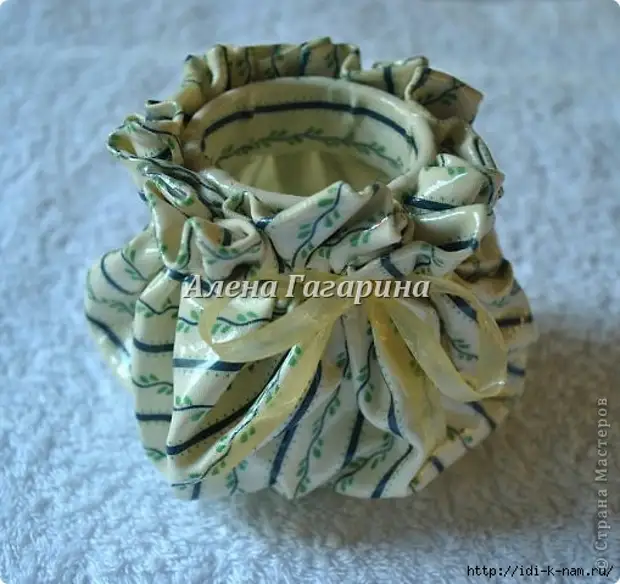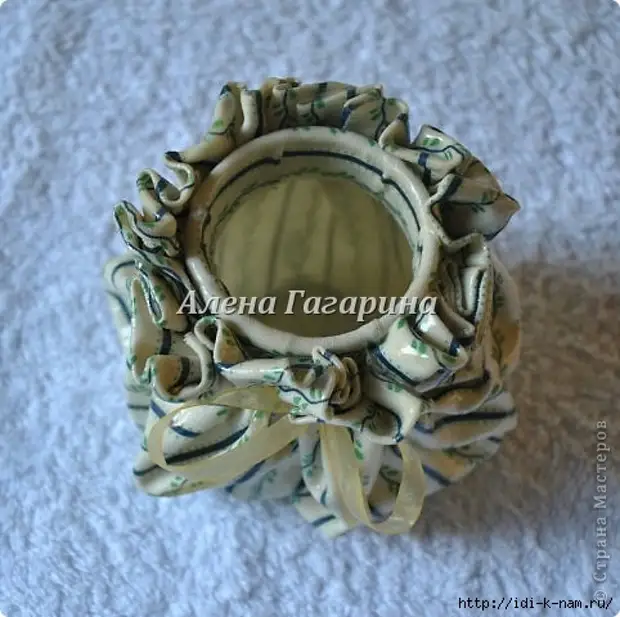
Glass jar. The cloth. PVA. And that's what happens ultimately
The technique itself is simple, but I like the result
(A jar is like a porcelain)

So,
1) Glass jar, it is desirable that she has a form. That is, rudely speaking "puzzled" jar, and not straight and not with concave walls. Why: Because the drape (folds) falls on the walls of the jar. Straight jars will ultimately get not so beautiful as "puzzled". You can drape not only jars, you can take a shape under the vase, the fuels. But I still recommend starting with jars. Light her, go further.
2) PVA glue (PowerTex composition is used in Italy). PVA is an adequate replacement of the composition of PowerTex. PVA must be diluted 1: 1 water. There should be a consistency of liquid sour cream. PVA should be able to get absorbed into the tissue. (Since Pva is an emulsion, so I'm talking about her in feminine)
3) Cotton fabric (100% Cotton). Italian insists that it can only be done with Cotton, but, as practice has shown .. You can take for these purposes and guipure, and chiffon. Just need to regulate the consistency of PVA. But I insist that you need to start with cotton. Purchase skill, understand technology ... And then experiment on health))
4) Rubber banking (the one that intercepts of money packs are intercepted). It is thick, not a tight, large diameter (what is needed).
5) Ribbon for a bow, which will then be tied around the neck of the jar.
6) Polyethylene, which you are offered a table and where your work will dry. . In no case do not need to do work on disposable paper tablecloths. Polyethylene does not absorb PVA, it does not dry out work, it is not sticking to it .. how long you did not bother with the product.
So you prepared
jar
the cloth
glue
gum
Ribbon
Polyethylene substrate for work.
Getting to work:
one) We are preparing for work fabric. From the fabric you need to make two parts - the shape for the draping itself and a leaf for the neck.
Detail First: Shape for drapery.
Fabric size depends on your jar. Put the jar on the fabric, we need to cut square. That is, measuring the fabric on the jar will be from four sides. Raise the fabric edge up (along the wall of the jar). The height of the fabric should be above the edge of the jar to the height of the middle finger. This is necessary so that the fabric can drag freely. Cut sill of fabric, removed the jar to the side.
Now we have to do from the square (preferably) the equilateral octagon. To do this, cut the corners of the square. It is not necessary to make a circle, then you will understand why, but the equilateral octagon is the thing that you need.
Detail Second: Beach for a jar neck.
The length of the beeper is measured by the diameter of your jar with a small allowance of 0.5 cm. You do not need to do this.
Beach height is two heights of your jar. Also, you need to squeeze on the jar. Grubly speaking, you wake the neck, gluing half of the beaks outside and wrapping the second half inside. In the photo, this squash on the neck can be seen.
2) We take a leaf. We make notches on it from one edge. Height of notches - "Up to half" along the entire length of the Beach. It is necessary in order for when you "refuel" the bay inside the jars, it will fall without wrinkles and assemblies. The inner diameter is less than external.
I take a conventional building brush for painting. Santimeter width is three approximately. The main requirement to the brush is not to climb the hairs. We scroll bay from two sides. We apply it to the neck jar. Shells refuel inside successively with each other ... not chaotically. Because if you lay them in succession, then avoid wrinkles. Fabric slightly dock. It will take out - it will be on the neck "like a native"))).
Gorlashko walked - pushed the jar into the sideline. Let him be waiting for his turn.
3) Now the main job. This stage is the most painstaking. The first time it can take a lot of time ... then you feel, you will understand everything to the end and time to leave there will be little.
We put in front of yourself prepared for the work "Octagon".
- First flashes the facial face with glue! Be sure to start with facial. Slip carefully so that you do not miss any patch. I smeared ... turn over.
- Wash off.
- Now we make challenges. Lapel - Well, it's like a girlfriend's sewing product, the edges are tested inside the inside. A half centimeter of the fabric from each edge of the octagon in one addition. If you look at the photo of the jar (on the neck), you will not see the inside of the fabric there, because the fabric is reconciled. PVA is well sticking out these challenges and keeps them well.
- The fabric lies in front of you. Promotional PVA, with challenges. Put in the center of the jar and start collecting a cloth around the jar neck. Collects folds not on the bank, but on the weight.
"Four-five faces of the octagon gathered in folds, took a banking banking, put it on the neck of banks and pressed her already collected folds. Collected two more edges of the octagon in folds - they were refueling under a rubber again. The rest of the fabric is already dragging right on the jar. Rubber helps you. She keeps the already obtained folds so that they do not crumble.
- Gathered all the fabric under a rubber on the neck, now you can correct the folds, straighten the neck, spread the fabric to your taste.
Why I said that the lap should be centimeter and a half ... no less. Because this lapse is just just falling under the rubber. These one and a half centimeters will not give the fabric to turn off the insanity and lie down under a bow carefully.
four) Take a ribbon. Tie her bows over a rubber. Rubber hide under the ribbon. Lossing the PVA ribbon, trying to impregnate it completely. And nodules, and loops, and tails.
five) We put a jar on polyethylene to dry. Saving it will be two days.
6) Two days later, we cover the jar of varnish. I highly recommend a glassy two-component varnish. After him, the jar will be like porcelain.
A jar will dry in an inverted form. Dress it either either on a bottle with a narrow neck (the edges of the jar should not come into contact with anything), or on the leg of some stand. At the thin end, turn the chair or stool, put on her a jar .. let it dry.
a source
